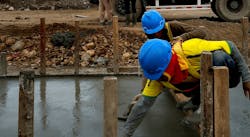HBI President Ed Brady’s Call to Action to Solve the Labor Shortage
At the International Builders’ Show (IBS) in Orlando last month, Ed Brady, president of the Home Builders Institute (HBI)—the educational arm of the national Association of Home Builders (NAHB)—led the call to action for solving the housing industry’s chronic skilled labor shortage.
At a press conference, Brady, and then-NAHB chairman Chuck Fowke, along with the association’s chief economist Robert Dietz, outlined the construction industry’s challenge of retaining, recruiting, and replacing skilled carpenters, framers, electricians, and plumbers (among other trades) to the tune of 2.2 million by 2025.
That tall order, based on recent research by Dietz and his team, factors in demand projections for new homes and buildings along with current job openings and other metrics, bringing the labor issue into sharper relief, if perhaps crisis mode. “It is one of the greatest challenges right now in our industry,” said Fowke, a Florida custom builder. “And it’s likely to get worse before it gets better.”
RELATED
- NAHB Chairman’s Message: Helping Home Builders Grow Their Businesses and Keep the U.S. Economy Humming
- 2022 Housing Forecast: Opportunities and Challenges
- 3 Ways Home Builders Can Address Labor Shortages by Investing in Trade Partners
To his credit, Brady—a past NAHB chairman himself—has HBI operating more than 400 programs in 47 states. Those programs graduate about 10,000 students per year, arming them with various trade skills. In addition, the institute also has 220 partner organizations, most recently adding the Boys & Girls Clubs of America.
Still, with the goal of filling 740,000 skilled labor jobs over the next three years, Brady isn’t (and can’t) simply be satisfied with the success to date. “This is a call to action for the entire industry, because we’re in crisis,” he says.
What Is the HBI’s Plan for Tackling the Labor Shortage in Construction?
I sat down with Ed after the press conference at IBS to probe deeper into how he thinks the industry can achieve its workforce goals.
Pro Builder: How would you respond to somebody who says you’re just spitting in the wind, that there’s just no way to get 2.2 million new construction workers in the next three years? I know that’s kind of cynical, but the track record indicates that.
Ed Brady: I have the same thoughts, and I don’t call myself cynical, either. Firstly, it’s a reach goal. Second, we plan to take a multifaceted approach.
One facet is that we have to retain the workers who are already here, so we can’t treat those who are in the industry poorly. We have to look at how we pay them, how we treat them as professionals, and how we take care of our workforce because the less turnover we have, the more we chip away at that goal.
And then we have to really go out and educate young people in this country that [construction] is a good career path, as opposed to going to college and coming out with a lot of student loan debt. We also have to improve productivity.
PB: Let’s focus on retention. We’ve heard from construction workers that they don’t feel safe on the jobsite and that they’re not valued or respected by the builders that hire them. Workers say they get paid poorly or not at all, while the builder or company owner reaps more profits and housing is in high demand. We also hear that, as independent contractors, they can’t earn benefits such as health insurance. How do you address those concerns and that culture?
EB: We need to take a look at the traditional business model for home builders and ask ourselves whether we are properly structured to attract, retain, and build the next generation of the nation's construction workforce. Can we—under the current model—create the sustained labor supply we require in this industry, which is expanding so rapidly?
We have to teach the home building industry how to treat its employees and subcontractors better because getting paid by the square foot or not getting paid when it rains isn’t sustainable. If we’re going to retain our labor force, we’re going to have to treat workers well. We need W-2s instead of 1099s in this industry. We need to demand that subcontractors treat their employees like home builders treat their employees. And so, with W-2s, comes paid vacation and the opportunity to call in sick if you're really sick, right? Professional development, advancement, respect … all of those things play an important part in retaining workers, too.
We have to teach the home building industry how to treat its employees and subcontractors better ... [I]f we don’t change that model, we’re still stuck in the same mud we have been for 30 years. And that is at a crisis level today because we haven't changed that model.
Of course, we have to build those benefits into the cost to build homes and balance it with housing affordability. But if we don’t change that model, we’re still stuck in the same mud we have been for 30 years. And that is at a crisis level today because we haven’t changed that model.
PB: What do you mean, specifically, when you talk about improving productivity?
EB: I’m talking about building houses more efficiently, building them faster, but still to a level of high performance and high quality. When I talk about production, I’m referring to a 45-year-old framing carpenter who can build a set of stair jacks in 30 minutes, whereas someone just trained is going to take 2 1/2 hours to complete the same work. I pay that newly trained person 12 bucks an hour, versus paying the veteran 20 bucks an hour. Who’s more productive? I think we're going to continue to lose productivity for a while as we bring in a well-trained workforce.
PB: What about alternative building methods, namely factory-built components and modules, as a way to boost productivity?
EB: You do need a really high level of skill at a certain level to do that. And there are transportation issues and significant capital costs with it, too. So, who’s going to invest the capital in that technology where there’s high risk? I’m a traditionalist, in that I think it’s difficult to build homes in a factory at scale. But I do think there’s an opportunity to create some efficiencies there.
PB: As part of your labor initiative, I know you’re also targeting women, minorities, and ex-military. What are barriers there, and how will you overcome them?
EB: Our current workforce has just 6% women in trade roles, so there’s a huge opportunity there, as is diversifying our workforce among lower incomes, minorities, and second chances, to veterans and transitioning military. It also means we have to rethink our nation’s immigration policy. Immigrants make up 30% of our workforce in the trades. As a country, and as a matter of policy, we need to provide a path for legal and illegal immigrants to come into our industry. We can’t ignore that.
RELATED
- Women Making Their Marks in Construction
- Q+A: How ConstructReach Is Taking Aim at the Construction Industry’s Labor Shortage and Workforce Diversity
- NAHB Launches Diversity Compact to Expand Opportunities
PB: How do you flip the script on the college-for-all policies that have decimated local and in-school vocational programs for a generation or more?
EB: Possibly our single most important task is to change entrenched and misguided perceptions of this industry and to reach out to the educators, influencers, middle schools, high schools, and those who influence young people’s career decisions. Working together to engage with local schools, we can get trades skill training curricula into educational institutions and we can train and provide educational opportunities that will inspire thousands of young people to pursue work in residential construction versus a path of higher education.
PB: I heard Robert Dietz tell a story about a group from HBI and NAHB attending a conference for high school guidance counselors and being asked, “What are you guys doing here?” And they learned that guidance counselors are judged by how many kids they get into four-year colleges. I knew parents were resistant to having their kids go into the trades instead of college, but I didn’t know there were incentives for guidance counselors to direct students to college. How do you break that barrier, or at least put some chinks in it?
EB: To start, it has to come from the policymakers because until that policy and funding is corrected, those counselors have no incentive to guide kids into the construction workforce. There also has to be pressure from parents and from administrators to do that. Until we provide similar resources for career development at the high school level beyond math and sciences, they’re going to continue to champion college for all.
It boils down to this: Workers today want greater respect, stability, and opportunity.
PB: What are those who want, or may want, to pursue a career path in the trades looking for?
EB: Certainly a good wage, but opportunities for advancement, training, and professional development exceed wages in the research we’ve seen and done. We haven’t looked at those things that are critical to our employer base. It boils down to this: Workers today want greater respect, stability, and opportunity.
PB: You’ve talked about opportunities for entrepreneurship in our industry. What are they?
EB: In our industry, most builders or subcontractors bring on somebody new, and four months later that person has their own pickup truck and their own business because they see the demand for homes and their trade and they want to start their own crew. It’s a huge opportunity for entrepreneurs in this industry, more than for almost any industry.
RELATED
- Solving the Labor Shortage in 12 Steps
- HBI: The Best-Kept Secret in Solving the Trade Labor Shortage
PB: To what extent have you considered or pursued a celebrity spokesperson as an advocate for HBI’s efforts?
EB: I’m hoping Drew Brees [former quarterback with the New Orleans Saints] is the beginning of that. He has invested millions of dollars in the BuildStrong workforce academies, and specifically a 10-year commitment to the BuildStrong Academy in New Orleans. NFL quarterback Jimmy Garoppolo is one of their spokespeople, too. His dad is a union electrician. So, yes, we’re trying to penetrate that network of voices people are listening to. We’re also talking about how we penetrate social media. There are bloggers out there with millions of followers. We need to be innovative in that approach.
PB: What about the U.S. Department of Labor? What kind of relationship do you have with it?
EB: We have a 47-year-long history with the Department of Labor. Our Job Corps program is embedded with them, so it's part of our DNA. I think that with continued support from the Biden administration, we’ll continue that program. It’s an expensive program, though, per student, and it’s struggling to find recruits. We have been, and will be, a feeder to that program, no matter where in the construction industry those students end up.
About the Author

Rich Binsacca, Head of Content
Rich Binsacca is Head of Content of Pro Builder and Custom Builder media brands. He has reported and written about all aspects of the housing industry since 1987 and most recently was editor-in-chief of Pro Builder Media. [email protected]

